Homelessness in Scotland: 2020 to 2021
This statistics bulletin provides information on homelessness in Scotland in the period from 1 April 2020 to 31 March 2021, alongside historical data.
The Extent of Homelessness in Scotland
Key Points
- 33,792 homeless applications in 2020/21, a decrease of 9% compared to 2019/20.
- 27,571 households were assessed as homeless in 2020/21, a decrease of 13% compared to 2019/20.
- These households contained 42,149 people, including 30,345 adults and 11,804 children.
- There were 13,097 households in temporary accommodation at 31st March 2021, an increase of 12% compared to March 31st 2020 but a decrease of 7% compared to the recent peak of 14,151 at 30th September 2020.
- 25,226 open homelessness cases in Scotland at 31st March 2021, a 10% increase compared to 31st March 2020 but a decrease of 7% compared to 30th September 2020.
Applications, assessments and households in temporary accommodation
2020/21 saw a number of changing trends in homelessness compared to previous years as a result of the impact of COVID-19.
| Measure | 2019/20 | 2020/21 | Change -Number | Change - Percentage |
|---|---|---|---|---|
| Applications | 37,043 | 33,792 | -3,251 | -9% |
| Assessed as homeless | 31,581 | 27,571 | -4,010 | -13% |
| Households in temporary accommodation at 31st March | 11,665 | 13,097 | 1,432 | 12% |
| Open homelessness applications at 31st March | 22,932 | 25,226 | 2,294 | 10% |
Table A shows there has been a decrease in the number of applications between 2019/20 and 2020/21 and the number of households assessed as homeless or threatened with homelessness. At the same time there has been an increase in the number of households in temporary accommodation and in the number of open homelessness cases.
The trends can largely be explained by changes in service use as a result of the COVID-19 pandemic. Some local authorities have reported a reduction in presentations as households were reluctant to approach homelessness services while COVID-19 guidelines advised households to remain at home, meaning households whose housing needs were less urgent opted to remain in their current accommodation. In addition, a reduction in the number of evictions due to emergency coronavirus legislation temporarily extending eviction notice periods likely also reduced the number of households presenting as homeless from social rented housing, and more noticeably from private rented housing.[3] Furthermore, home repossessions were also temporarily banned in this period.[4]
COVID-19 restrictions limited the ability of local authorities to move households in to permanent accommodation, and therefore close cases, explaining the increase in the number of open homelesssness cases. This included difficulties in carrying out necessary repairs, challenges conducting viewings due to households shielding or self-isolating, and a lower level of lets due to staff, especially registered social landlords, being furloughed.
There are a couple of reasons for the increase in the number of households in temporary accommodation. First, the rise in the number of open cases increased overall demand for temporary accommodation. In addition, some households who had previously chosen not to take up temporary accommodation provided by the local authority, now required it as the alternative arrangements they had made were no longer viable due to the pandemic.
Chart 1 shows that the number of households assessed as homeless was lower in every quarter for 2020/21, with the biggest decrease being in April to June, when the pandemic first started. The smaller decrease between July and September may be due to fact there were easing of restrictions over this period.
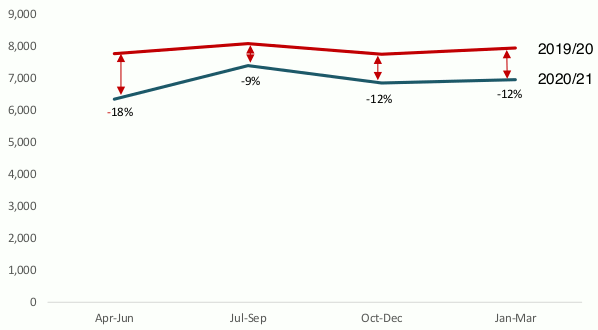
Chart 2 shows that there was a sharp increase in the number of households in temporary accommodation immediately following the onset of the pandemic. This reached a peak in September with numbers in temporary accommodation decreasing since then, although they are still much higher compared to the previous year. This chart also shows that the increase for households with children and/or pregnant women in temporary accommodation isn’t as steep as for households overall (12% increase for all vs 2% for households with children/ pregnant women). There were a total of 7,130 children in temporary accommodation at 31st March – a decrease of 2% (from 7,280) the previous year. (Tables 26-28)
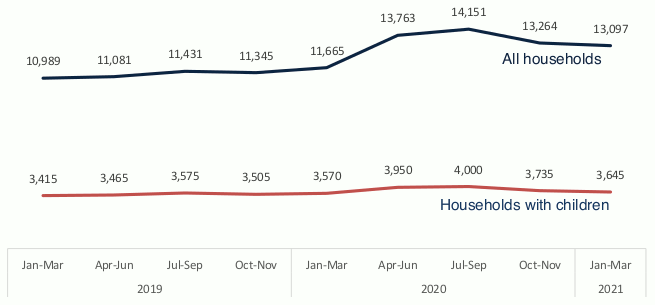
Changes in homelessness assessments
Of the 27,571 homeless households in 2020/21, 27,111 (98%) were assessed as unintentionally homeless, with the remaining 460 assessed as intentionally homeless. The decrease in the proportion assessed as intentionally homeless compared to last year (1% vs 3%) is likely due to changes in legislation which, from November 2019, allows local authorities the choice whether to assess for intentionality rather than it being a legal duty to do so. (Table 8)
Longer-term trends
2020/21 has been an unusual year, and therefore it is difficult to know if the trends seen between this year and last are likely to continue and/or how trends will be affected moving forward as we exit from the COVID-19 pandemic. Chart 3 provides a view of the longer-term trends which have been experienced in homelessness; this shows the impact previous homelessness legislation, policy and practice have had prior to 2020/21.
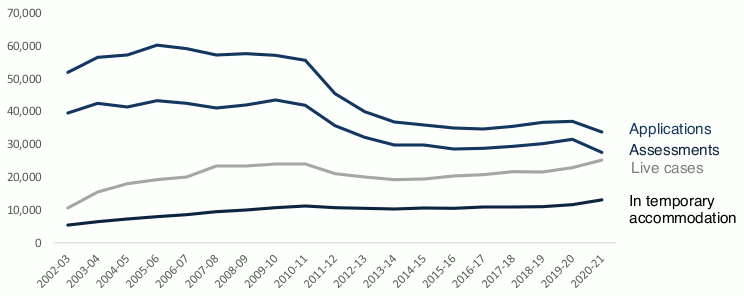
In 2001, Scottish homelessness legislation[5] extended councils’ duties to non-priority need homeless households, with the priority need test being abolished on 31st December 2012[6]. Before 2002, the majority of homeless households in priority need were households with children. Following the 2001 extension duty there was a notable increase in the number of single people applying for homelessness assistance. These single people were also eligible for temporary accommodation. This can, at least in part, explain the increases from 2002/03. The sharper decrease shown from 2009/10 is likely due to the impact of the introduction of Housing Options services in Scottish local authorities, with a focus on prevention.
Number of households vs number of people
While data is provided and reported at a household level, local authorities record the number of people attached to applications, and it is therefore possible to understand how many people are affected by homelessness.
The 27,571 homeless households in 2020/21 contained a total of 42,149 people, comprising 30,345 adults and 11,804 children (Tables 13, 14 & 15). While the number of adults fell by 16% compared to 2019/20, the number of children decreased by 26%. This is due to the greater proportion of households without children assessed as homeless in this period (75% in 2020/21 compared to 71% in 2019/20).
Data is collected for the number of children in temporary accommodation, but not the number of adults.
How does homelessness vary across Scotland?
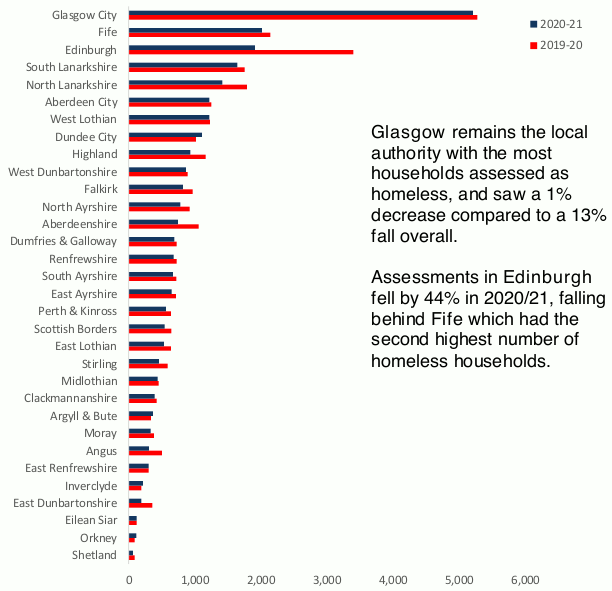
Local authority figures can be found in Table 11 of the accompanying data tables.
The 44% reduction in households (from 3,402 to 1,912) in Edinburgh is largely due to a fall in households becoming homeless from a private rented tenancy and from living with friends or relatives. There was a 67% reduction from a private rented tenancy (264 in 2020/21 compared to 802 in 2019/20) in Edinburgh compared to 42% nationally. Edinburgh also experienced a decrease of those becoming homeless from either ‘parental / family home / relatives’ or ‘friends / partners’ of 35% (from 1,532 to 1,002) compared to a national increase of 7%.
Glasgow and Edinburgh had the highest number of households in temporary accommodation, 2,668 and 2,168 respectively, as at 31st March 2021. Note, that there were only a third as many households in temporary accommodation in Fife (708) compared to Edinburgh, depsite their numbers of homeless households in Fife being greater. Edinburgh experienced an increase of 300 (16% from 1,868) from 2019/20. Other notable increases were seen in West Lothian (220, 49%), Dundee City (212, 87%) and Fife (183, 35%). (Table 26)
Comparing homelessness figures with the population for each local authority (i.e. rates) provides a useful insight as to how homelessness varies across Scotland.
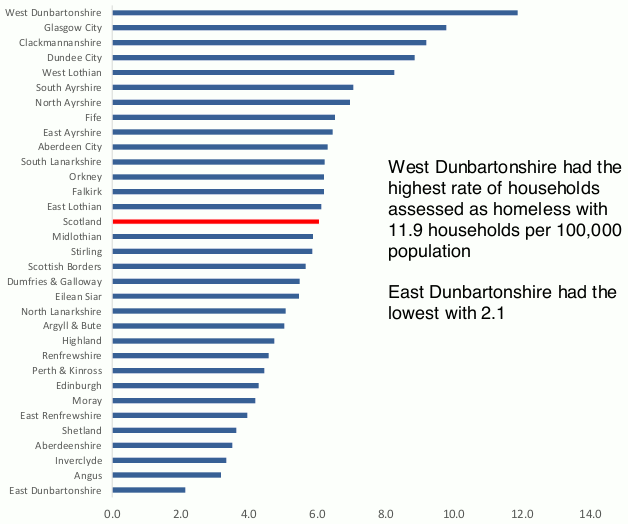
Rates for homeless households can be found in Table 12 of the accompanying data tables.
As part of the assessment stage of a homelessness application, local authorities can investigate whether the applicant has a local connection to the authority to which they applied or to another local authority. This can be on the basis of residency, employment, a family connection or another special reason such as health reasons or education. Where a local connection with another local authority exists the local authority may refer the applicant to that authority, otherwise the duty lies with the authority the application was made to. A local authority may choose not to refer the household e.g. if an application was made for the reason of fleeing from domestic abuse.
In 2020/21, 93% of homeless households had a connection to the local authority to which they made their application. A further 5% had no local connection to any local authority within Scotland. This means, only 2% (605) of homeless households had a connection to another local authority other than the one they made an application to. The majority of these were in Glasgow (415, 69% of total). As Glasgow only referred 15 cases in 2020/21, this helps explain the disproportionately high levels of homelessness in Glasgow, although does not account for it fully. West Dunbartonshire’s high rates of homelessness cannot be explained by those with a local connection elsewhere with 99% of households having a local connection with that authority. (Tables 24 & 52)
Interestingly, the use of temporary accommodation does not follow the same pattern (in terms of rates) as the number of homeless households at a local authority level. This implies some local authorities have a disproportionately high use of temporary accommodation, while others are disproportionately low.

Rates for temporary accommodation by local authority are detailed in Table 32 of the accompanying data tables.
Key Points
- Being ‘asked to leave’ and was the most common reason for homelessness, increasing to 27% from 24% in 2019/20.
- 22% gave ‘Dispute within household / relationship breakdown: non-violent’ as the main reason, compared to 19% in 2019/20. 14% gave ‘Dispute within household: violent or abusive’.
- The proportion of households giving ‘other action by landlord resulting in the termination of the tenancy’ fell from 9% to 4%.
- 42% decrease in households becoming homeless from a private rented tenancy. A higher proportion became homeless from accommodation shared with friends, relatives or partners.
Contact
There is a problem
Thanks for your feedback